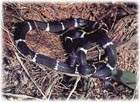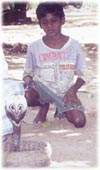| Plus |
|
|||||
|
Gypsy
touch to combat snake-bite
The project is novel because it will mix the expertise of widely varying groups - the earthy common sense of the humble ahukuntika clan from the outbacks of Kudagama, off Tambuttegama and the scientific knowledge of the Department of Clinical Medicine under the guidance of Prof. Rezvi Sheriff in Colombo and the University of Oxford across the seas in England. Already a Snake Venom Research Laboratory has been set up and the Department of Clinical Medicine is working closely with wildlife officials to start a herpetarium, to meet a long felt need. A need acutely and sometimes tragically felt by snake-bite victims. In 2000, there were 48,000 reported incidents of snake-bite, with 194 deaths in the country, but the figure could be higher as some cases go unreported. Ironically, Sri Lanka which is quite well-known for its poisonous snakes, with some ancient records even indicating the existence of anacondas those days, has so far had no means of producing its own anti-venom serum. "The treatment for poisonous snake-bite, is to inject anti-venom serum to neutralize the venom in the blood. But we don't have proper anti-venom for indigenous snakes because we have been importing all requirements of the serum from India. That is not suitable, as even within Sri Lanka there are geographical variations, for example, the Russell's Viper's," explains Dr. Ariyarani Ariyaratnam of the Department of Clinical Medicine.
The serum, which the country has been importing for over 50 years is not specific for local snakes and could also have adverse reactions such as fever, chills and rigours, respiratory difficulties and blood pressure drops in patients which could sometimes even be fatal. In 1985, the Health Ministry and the Oxford University conducted research in Anuradhapura and lab tests with the imported antivenom and found that it didn't fully clear the blood of victims of the venom. "The need for our own anti-venom became acute," says Dr. Ariyaratnam. By 1995, the Medical Faculty made a start in this direction by sending live local snakes to Liverpool University. There they were milked and the venom provided to a company to produce the anti-venom serum that was specifically required for the treatment of Sri Lankan patients. The anti-venom was then used for clinical trial studies in Anuradhapura conducted by the Oxford-Colombo Snake Bite Research Group under Prof. Sheriff and Prof. David Warrel of Oxford. Conceding that this was a costly method and considering the large number of victims of snake bite, the Medical Faculty has taken another step to set up its own research lab and herpetarium. They will then keep the snakes there, milk the venom, freeze it and send it abroad, maybe to a country close by such as India for 'custom-made' serum for Sri Lanka. That's where the gypsies come in, for what better snake-catchers are there? The Medical Faculty has already made contact with the gypsy community living in Kudagama, just off the Tambuttegama-Kurunegala Road, a path we traversed on a lazy Sunday. Tall grass lines the red, gravel road and brick houses gradually give way to thatched cottages. There is a hint of rain as we go in search of the Arachchi of Kudagama. A youth with curly black hair and sparkling eyes cycling furiously along the road, becomes our guide, for he happens to be the Arachchi's nephew. Suddenly we come upon the colony. Dogs, cats, hens and piglets roam the tiny plots of land around the neatly-thatched wattle and daub homes of the gypsies. A baby is fast asleep in a 'saree cradle' hung from the branch of a tree. Young children and girls loiter around curious to find out our business. We are on a strange mission. To talk to the gypsies about their expertise on snakes. Theirs is the down-to-earth indigenous knowledge of people living off the land. For them the snake represents their livelihood. They catch them, pull out their fangs and use the reptiles for 'dancing and charming' or to put around tourists' necks to earn a few rupees for their daily rice and curry. Michael, the Arachchi smiles warmly showing us his red betel-stained teeth. His nephew has already told him our business. Yes, they are snake charmers and know how to handle snakes. In their free time they cultivate the land to make ends meet. That day most of his relatives had gone to the cities with their small entourage of snakes, monkeys and women who say 'saasthare'. "Colombo people have asked for our help and we'll assist them," says Michael, explaining that they catch snakes such as the polonga, nagaya and pimbura in wela areas in Polgahawela. "We catch them by the tail and keep a stick to their heads and then pull out the fangs with a small knife. The fangs need to be removed once a week. When the fangs are pulled out, the venom comes out like frothy soap." The Medical Faculty has other ideas on how to treat the snakes. "We will not harm them or remove their fangs. We plan to milk the venom without harming or injuring the snakes. We will look after the snakes and feed them," says Dr. Ariyaratnam. Snakes are the bane of the poor rural folk in areas such as Anuradhapura, Polonnaruwa, Kurunegala and Vavuniya. The Common Krait bites people while they are sleeping on the floor and other folk get bitten while working in the fields. But cities too are not free of these reptiles, with Colombo reporting Hump-nosed Viper bites. With plans afoot to make our own anti-venom eventually, there is hope that the number of deaths from snake-bite could be cut down drastically in Sri Lanka. |
||||||
Copyright © 2001 Wijeya Newspapers
Ltd. All rights reserved. |
 scaled
Viper (weli polonga), Hump-nosed Viper (kuna katuwa or polon
thelissa), Cobra (nagaya), Common Krait (thel karawala), Ceylon
Krait (magamaruwa) and Green-pit Viper (pala polonga).
scaled
Viper (weli polonga), Hump-nosed Viper (kuna katuwa or polon
thelissa), Cobra (nagaya), Common Krait (thel karawala), Ceylon
Krait (magamaruwa) and Green-pit Viper (pala polonga). 